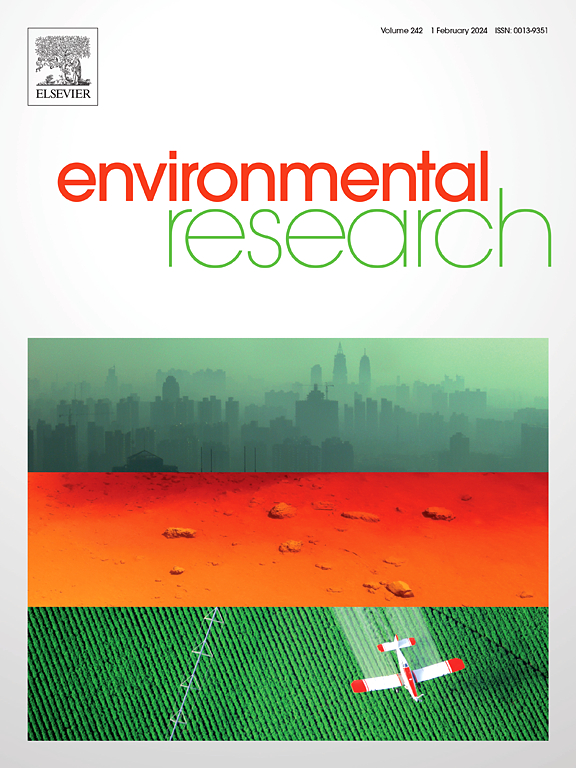Yolk-shell CoFe2O4@hollow mesoporous carbon spheres for Levofloxacin hydrochloride removal: Synergy enhancement effect of adsorption and degradation
IF 7.7
2区 环境科学与生态学
Q1 ENVIRONMENTAL SCIENCES
引用次数: 0
Abstract
A yolk-shell structured magnetic composite catalyst with hollow mesoporous carbon spheres as the shell and CoFe2O4 nanoparticles as the core (CoFe2O4@HMCS) was successfully designed and synthesized for peroxymonosulfate (PMS) activation to degrade levofloxacin hydrochloride (LFX). Hollow mesoporous carbon spheres (HMCS) possess tunable hollow mesoporous structures, serving as both an excellent adsorbent and catalyst. However, its adsorptive function in catalytic degradation processes has been easily ignored. This work highlights the remarkable adsorption capacity of CoFe2O4@HMCS (qe = 404.32 mg g−1). During the synergistic process of adsorption and degradation, LFX can be rapidly and efficiently enriched by CoFe2O4@HMCS, achieving 93.42 % removal within 60 min through subsequent synergistic degradation. The HMCS can stabilize CoFe2O4 under complex reaction conditions, reducing Co/Fe leaching. Simultaneously, the combination of HMCS and CoFe2O4 also endows HMCS with magnetic properties, which further enhances the catalytic performance of the composite material. Furthermore, a dual-pathway mechanism for PMS activation was proposed, demonstrating that both radical (SO4−• and •OH) and nonradical (direct electron transfer) pathways cooperatively contributed to LFX degradation through PMS activation, with the direct electron transfer mechanism playing a dominant role. Meanwhile, the potential transformation pathways of LFX were elucidated. This research aims to develop a magnetically recoverable catalyst with strong adsorption and catalytic capabilities for more practical water treatment applications.
蛋黄壳CoFe2O4@hollow中孔碳球去除盐酸左氧氟沙星:吸附和降解的协同增强效应
设计并合成了以中空介孔碳球为壳,CoFe2O4纳米颗粒为核(CoFe2O4@HMCS)的壳壳结构磁性复合催化剂,用于过氧单硫酸盐(PMS)活化降解盐酸左氧氟沙星(LFX)。中空介孔碳球具有可调的中空介孔结构,是一种优良的吸附剂和催化剂。然而,其在催化降解过程中的吸附作用却很容易被忽视。这项工作突出了CoFe2O4@HMCS (qe = 404.32 mg g−1)的显著吸附能力。在吸附和降解协同过程中,通过CoFe2O4@HMCS可以快速高效地富集LFX,通过后续的协同降解,在60 min内达到93.42%的去除率。在复杂的反应条件下,HMCS可以稳定CoFe2O4,减少Co/Fe浸出。同时,HMCS与CoFe2O4的结合还赋予了HMCS磁性能,进一步增强了复合材料的催化性能。此外,还提出了PMS活化的双途径机制,表明自由基(SO4−•和•OH)和非自由基(直接电子转移)途径通过PMS活化共同促进LFX降解,其中直接电子转移机制起主导作用。同时阐明了LFX的潜在转化途径。本研究旨在开发一种具有强吸附和催化能力的磁可回收催化剂,用于更实际的水处理应用。
本文章由计算机程序翻译,如有差异,请以英文原文为准。
求助全文
约1分钟内获得全文
求助全文
来源期刊

Environmental Research
环境科学-公共卫生、环境卫生与职业卫生
CiteScore
12.60
自引率
8.40%
发文量
2480
审稿时长
4.7 months
期刊介绍:
The Environmental Research journal presents a broad range of interdisciplinary research, focused on addressing worldwide environmental concerns and featuring innovative findings. Our publication strives to explore relevant anthropogenic issues across various environmental sectors, showcasing practical applications in real-life settings.
 求助内容:
求助内容: 应助结果提醒方式:
应助结果提醒方式:


